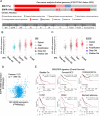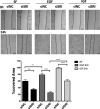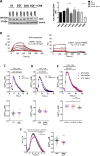Sorcin promotes migration in cancer and regulates the EGF-dependent EGFR signaling pathways
- PMID: 37442828
- PMCID: PMC10345051
- DOI: 10.1007/s00018-023-04850-4
Sorcin promotes migration in cancer and regulates the EGF-dependent EGFR signaling pathways
Abstract
The epidermal growth factor receptor (EGFR) is one of the main tumor drivers and is an important therapeutic target for many cancers. Calcium is important in EGFR signaling pathways. Sorcin is one of the most important calcium sensor proteins, overexpressed in many tumors, that promotes cell proliferation, migration, invasion, epithelial-to-mesenchymal transition, malignant progression and resistance to chemotherapeutic drugs. The present work elucidates a functional mechanism that links calcium homeostasis to EGFR signaling in cancer. Sorcin and EGFR expression are significantly correlated and associated with reduced overall survival in cancer patients. Mechanistically, Sorcin directly binds EGFR protein in a calcium-dependent fashion and regulates calcium (dys)homeostasis linked to EGF-dependent EGFR signaling. Moreover, Sorcin controls EGFR proteostasis and signaling and increases its phosphorylation, leading to increased EGF-dependent migration and invasion. Of note, silencing of Sorcin cooperates with EGFR inhibitors in the regulation of migration, highlighting calcium signaling pathway as an exploitable target to enhance the effectiveness of EGFR-targeting therapies.
Keywords: Calcium; Cancer; EGF; EGFR; Epithelial-to-mesenchymal transition; Invasion; Migration; Signaling; Sorcin.
© 2023. The Author(s).
Conflict of interest statement
The authors declare that they have no competing interests.
Figures







Similar articles
-
Caveolin-1 inhibits the proliferation and invasion of lung adenocarcinoma via EGFR degradation.Sci Rep. 2025 Jul 1;15(1):21654. doi: 10.1038/s41598-025-05259-8. Sci Rep. 2025. PMID: 40594106 Free PMC article.
-
Expression of nucleostemin, epidermal growth factor and epidermal growth factor receptor in human esophageal squamous cell carcinoma tissues.J Cancer Res Clin Oncol. 2010 Apr;136(4):587-94. doi: 10.1007/s00432-009-0693-2. Epub 2009 Oct 13. J Cancer Res Clin Oncol. 2010. PMID: 19823871 Free PMC article.
-
Epidermal growth factor receptor signaling governs the host inflammatory response to invasive aspergillosis.mBio. 2024 Dec 11;15(12):e0267124. doi: 10.1128/mbio.02671-24. Epub 2024 Oct 30. mBio. 2024. PMID: 39475281 Free PMC article.
-
First-line treatment of advanced epidermal growth factor receptor (EGFR) mutation positive non-squamous non-small cell lung cancer.Cochrane Database Syst Rev. 2016 May 25;(5):CD010383. doi: 10.1002/14651858.CD010383.pub2. Cochrane Database Syst Rev. 2016. Update in: Cochrane Database Syst Rev. 2021 Mar 18;3:CD010383. doi: 10.1002/14651858.CD010383.pub3. PMID: 27223332 Updated.
-
Adjuvant epidermal growth factor receptor (EGFR) tyrosine kinase inhibitors (TKIs) for the treatment of people with resected stage I to III non-small-cell lung cancer and EGFR mutation.Cochrane Database Syst Rev. 2025 May 27;5(5):CD015140. doi: 10.1002/14651858.CD015140.pub2. Cochrane Database Syst Rev. 2025. PMID: 40421698 Review.
Cited by
-
EGF receptor in organ development, tissue homeostasis and regeneration.J Biomed Sci. 2025 Feb 19;32(1):24. doi: 10.1186/s12929-025-01119-9. J Biomed Sci. 2025. PMID: 39966897 Free PMC article. Review.
-
The supramolecular polymer-related signature predicts prognosis and indicates immune microenvironment infiltration in gastric cancer.Clinics (Sao Paulo). 2025 Apr 13;80:100641. doi: 10.1016/j.clinsp.2025.100641. eCollection 2025. Clinics (Sao Paulo). 2025. PMID: 40228435 Free PMC article.
-
Sorcin in Cancer Development and Chemotherapeutic Drug Resistance.Cancers (Basel). 2024 Aug 9;16(16):2810. doi: 10.3390/cancers16162810. Cancers (Basel). 2024. PMID: 39199583 Free PMC article. Review.
-
The causal relationship between inflammatory cytokines and lung cancer: a two-sample bidirectional mendelian randomization study.Discov Oncol. 2025 Aug 22;16(1):1592. doi: 10.1007/s12672-025-03256-x. Discov Oncol. 2025. PMID: 40841865 Free PMC article.
-
The alternative polyadenylation regulator CFIm25 promotes macrophage differentiation and activates the NF-κB pathway.Cell Commun Signal. 2025 Feb 28;23(1):115. doi: 10.1186/s12964-025-02114-1. Cell Commun Signal. 2025. PMID: 40022203 Free PMC article.
References
MeSH terms
Substances
Grants and funding
LinkOut - more resources
Full Text Sources
Medical
Research Materials
Miscellaneous

